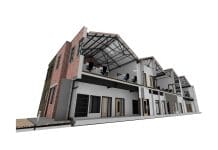Kate Royse Director for Environmental Modelling and Russell Lawley Team Leader for Product development – GeoProperties at the British Geological Survey details how the new BGScivils data product will help put the subsurface into BIM
BGS has recently developed, and released BGScivils, which is a suite of engineering property datasets specifically designed for BIM applications. They demonstrate the spatial distribution of geological unit properties for the uppermost 2m across Great Britain. Properties of earth materials are important for all engineering projects and the classification of properties provided by this suite of datasets can be used in all ground developments to give a generic assessment informing engineers and planners at the pre-tender and desk study stage of likely ground conditions at their site.
This allows for a far more efficient tender preparation, planning and execution of subsequent ground investigations. BGS Civils consists of 7 individual data layers:
Strength
The strength of geological materials is related to their composition, density, and how their mineral components are bound together, i.e. interlocking grains or cementation. The strength of the rock mass is also affected by mechanical discontinuities, such as fissures, joints, shears and faults. Alteration, such as weathering of the material also causes changes in strength, usually weakening the material. However, weathering can also lead to the formation of hardpans, which strengthen the soil or rock. This theme provides information on zones of rock strength (based on field descriptions of materials) as part of a suite of GIS layers for different engineering parameters. The classification used in the dataset is based upon the British Standard 5930 (BSI 2015) code of practice for site investigation and provides as minimum, maximum and typical strengths.
Excavatability
A number of methods have been devised to efficiently and cost-effectively remove material such as digging, ripping or use of explosives. The selection method depends on the characteristics of the material to be removed e.g. strength and the presence of joints or fractures etc. The data layer provides information on the BS5930 classification of strength together with the most suitable mode of extraction from blasting to using hand tools.
Discontinuities
Discontinuities are defined as any break or change in the continuity of a rock mass that has the potential to reduce rock mass strength. Discontinuities can be fractures, faults, joints, cleavage, or bedding planes etc. This theme provides information on the discontinuities in bedrock and superficial deposits. The classification uses 4 descriptors, based on BSI5930, BSI2015 and ISRM 2007 standards, to describe the bedding (laminated or bedded), foliation (e.g. slatey, schistose), rock mass (e.g. massive or irregular) and includes all fractures (e.g. jointing, faulting).
Bulking of soils and rocks
When rocks and soils are excavated this is usually accompanied by an increase in volume. This is change is referred to as the ‘bulking factor’. The bulking factor is influenced by a number of different characteristic including the mineralogy, particle size and shape, porosity, density, strength, weathering and extraction method. The dataset provides an indication of the typical bulking factor ranges for lithology class and rock type, and gives a review of likely material handling needs.
Sulfate and sulfide potential
The presence of sulphur in rocks and soils, when in certain forms and under adverse conditions, is of importance to the engineered environment as it can give rise to aggressive ground conditions, affecting the resilience of concrete structures and inducing volumetric changes in engineered soils. It is therefore important to know where these conditions may occur. This data set provides a guide to the potential sulfate and sulphide geohazard for rock units found at the surface. It provides an indicator of the presence of primary sulfate and the potential presence or likely formation of sulfate species due to oxidation. Corrosivity (ferrous)
As underground structures and pipes get older, their potential to fail as a result of surface pitting and corrosion increases. The cost in the UK of corrosion to these structures has been estimated at 4 percent of GNP per year (Institute of Corrosion). Some of this cost comes in the form of corrosion to underground iron structures (e.g. pipes), particularly in what are termed ‘aggressive soils’. The BGS Corrosivity dataset is a GIS layer supporting the management of underground iron assets that has been created in response to the growing awareness of the cost of maintenance of structures such as pipelines and building foundations. This dataset identifies where the ground beneath the topsoil has potentially ‘corrosive’ or ‘aggressive’ characteristics and places them within the recognised scoring framework developed by the Cast Iron Pipe Research Association (CIPRA) now the Ductile Iron Pipe Research Association (DIPRA).
Use for engineered fill
‘Fill’ is a material that is used to fill in a depression or hole in the ground, or create mounds or otherwise artificially change the elevation of the ground. These may include earthworks such as infill, raising or levelling ground, embankments, foundation pads, road bases and landscaping. Fill may be engineered or non-engineered:
- Engineered fill is selected, placed and compacted to an appropriate specification in order that it will exhibit the required engineering behaviour.
- Non-engineered fill usually involves the disposal of waste materials. Normally such fill would occur on sites where uncontrolled filling has taken place and therefore no reliance can be placed on the type of fill material and method of placement.
The classification for the engineered fill theme primarily follows the Highways England ‘specification for highway works’ series 600 Earthworks (1991). The dataset includes alternative uses for some materials; these alternatives are based on information derived from Britpits, the BGS database for quarries and mines.
During 2016 the BGScivils datasets will be joined by two additional layers; firstly Engineering rockhead (which provides depth estimates to where the rock has adequate bearing capacity for large structures), and secondly, an engineering foundation dataset (which provides an overview of typical features and problems with foundations within given geological materials).
For more information on how to obtain and use these datasets please contact the Digital Data team at BGS digitaldata@bgs.ac.uk .
Dr Kate Royse
Science Director of Environmental Modelling
British Geological Survey













